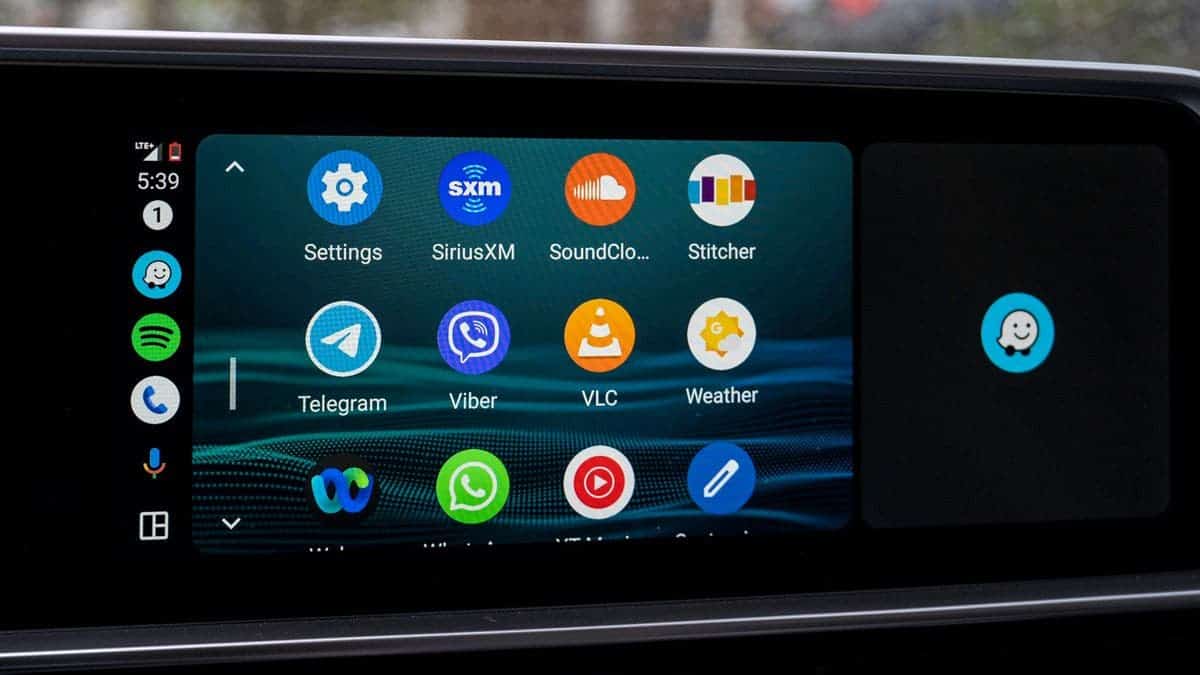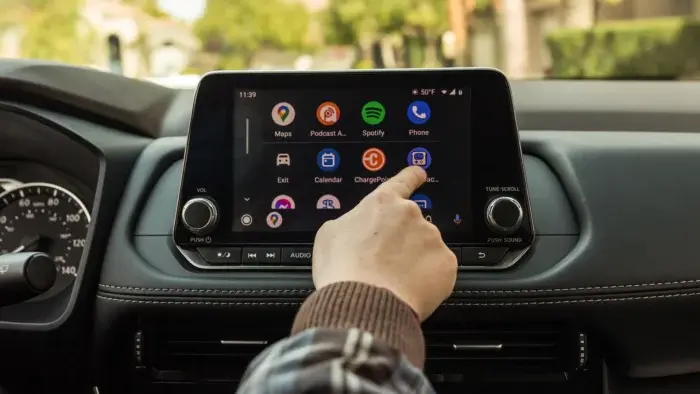Google recently released the stable version of Android Auto 12.2, following a beta testing period. This update aims to address some lingering issues and introduce a subtle design change to enhance user experience. Let’s delve deeper into the details of Android Auto 12.2.
Android Auto 12.2: A Closer Look at the Latest Update
Streamlined Update Process and Focus on Stability
Previously, users enrolled in the beta program received early access to new features. Now, Android Auto 12.2 is readily available for download through the Google Play Store. This streamlined approach ensures a wider and more uniform rollout, potentially minimizing compatibility issues. Google’s focus on stability suggests a continuation of efforts to address reported problems encountered in earlier versions. While the official changelog might not reveal extensive changes, the update likely incorporates internal improvements and bug fixes aimed at enhancing overall performance and reliability.
Gray Icons: A Clear Distinction for Stationary-Use Apps
The most noticeable change in Android Auto 12.2 is the introduction of grayscale icons for applications that are unavailable while the car is in motion. This design shift follows previous iterations where unavailable apps were marked with a superimposed car icon or the letter “P” (for parking). The grayscale approach offers a more subtle yet clear distinction. When the car is running, icons for apps like GameSnacks minigames or the “Customize” shortcut appear desaturated, indicating their inoperability. Tapping on these icons triggers a message stating “Not available while driving,” reinforcing the safety-conscious design principle. When the car is stationary and parked, the icons revert to their normal color scheme, signifying their full functionality.
Potential for Unannounced Enhancements
While the readily apparent change revolves around icon highlighting, it’s important to acknowledge the possibility of additional, under-the-hood improvements. Google’s development process often involves backend modifications that enhance stability and optimize performance without necessarily translating into immediate user-facing changes. These internal refinements contribute to a smoother and more reliable user experience with Android Auto.
Updating to Android Auto 12.2
The update for Android Auto 12.2 (version 12.2.6424) is being rolled out through Google Play. Here’s a step-by-step guide on how to verify your current version and update to the latest one:
- Check Your Current Version: Open the Android Auto app on your phone. Navigate to the settings menu and locate the “About” section. This will display your current version of Android Auto.
- Update Through Google Play: If you’re not already on version 12.2.6424, launch the Google Play Store app. Tap on your profile picture in the top right corner and select “Manage apps & device.” Next, tap “Updates available” and look for Android Auto on the list. If an update is available, tap “Update” to initiate the download and installation process.
- Manual Update via APKMirror (Optional): In case the update hasn’t reached your device yet through Google Play, you can download the Android Auto 12.2 APK (application package file) from a trusted source like APKMirror. Be cautious when downloading APKs, and only use reputable sources to avoid potential malware risks. Once downloaded, open the APK file using your device’s package installer and follow the on-screen prompts to complete the update.
The Future of Android Auto: A Glimpse into the Road Ahead

While the specifics remain under wraps, rumors and industry trends suggest exciting possibilities for the future of Android Auto. Here are some potential areas of development:
Gizchina News of the week
- Enhanced Customization: Imagine a personalized Android Auto experience tailored to your preferences. Users might be able to customize the layout, prioritize specific apps, or even integrate widgets for frequently used functions.
- Deeper Integration with Google Assistant: A more seamless integration with Google Assistant could unlock powerful voice-controlled features. Imagine controlling music, navigation, or even making calls without ever taking your eyes off the road.
- Focus on Connected Car Features: The rise of connected cars opens doors for Android Auto to tap into vehicle diagnostics, real-time traffic updates, or integrate with advanced driver-assistance systems (ADAS) for a more informed and safer driving experience.
- Expansion Beyond Phone Mirroring: Android Auto might evolve beyond simply mirroring your phone’s interface. Imagine a dedicated app store for car-optimized applications designed specifically for in-car use, prioritizing safety and ease of access.
- Multi-Display Support: With the increasing adoption of multi-screen dashboards in modern cars, Android Auto could adapt to leverage these displays, offering a more immersive and informative user experience.
Prioritizing Safety: Design for a Focused Drive
Android Auto prioritizes safety by discouraging interaction with certain applications while driving. This design philosophy is crucial in a world where distractions behind the wheel can have devastating consequences. The use of grayscale icons and the “Not available while driving” message are clear examples of this commitment.
Here are some additional safety features embedded within Android Auto:
- Voice Commands: Android Auto heavily promotes voice interaction, minimizing the need for drivers to take their hands off the wheel or eyes off the road.
- Do Not Disturb Mode: This mode silences notifications and messages, preventing distractions while driving.
- Simplified Interface: The interface is designed for ease of use, with large buttons and minimal text to reduce cognitive load on the driver.
By prioritizing safety through its design, Android Auto empowers drivers to stay focused on the road while still enjoying convenient access to essential in-car functionalities.
Navigating the Competition: Standing Out in the In-Car Arena
The in-car entertainment system landscape is populated by several competitors, each vying for user adoption. Here’s a quick comparison of Android Auto with some key players:
- Apple CarPlay: Apple’s CarPlay offers a user-friendly and tightly integrated experience for iPhone users. However, its customization options are limited compared to Android Auto.
- Third-Party Systems: Car manufacturers often offer their own in-car entertainment systems. While these systems can be well-integrated with specific vehicle features, they may lack the app ecosystem and versatility of Android Auto.
Android Auto differentiates itself through its:
- Openness: Android Auto’s compatibility with a wider range of Android phones and car models grants users more flexibility.
- App Ecosystem: The vast library of compatible apps on the Google Play Store offers greater functionality and user choice.
- Google Assistant Integration: The tight integration with Google Assistant provides a powerful voice-controlled experience unmatched by many competitors.
Troubleshooting Common Hiccups: Keeping Your Drive Smooth
Despite its functionalities, Android Auto can occasionally encounter issues. Here are some common problems and their potential solutions:
- Connection Problems: Ensure a stable Bluetooth or wired connection between your phone and the car’s infotainment system. Restart both devices if the issue persists.
- App Compatibility Issues: Not all apps are optimized for Android Auto. Check for app updates and consult the developer’s information for compatibility details.
- Voice Recognition Malfunctions: Ensure your microphone is not obstructed and that your internet connection is stable. Calibrate the voice recognition settings within the Android Auto app.
If you encounter issues beyond these, consulting online resources or contacting Google support can provide further assistance.
Android Auto 12.2 represents a continued commitment by Google towards refining the in-car experience. While the primary focus seems to be on stability improvements, the introduction of grayscale icons offers a user-friendly way to distinguish between car-operable and non-operable applications. As Android Auto continues to evolve, future updates may introduce more prominent changes and features. By staying updated, users can benefit from the latest enhancements and ensure a safe and enjoyable driving experience with Android Auto at the helm.





